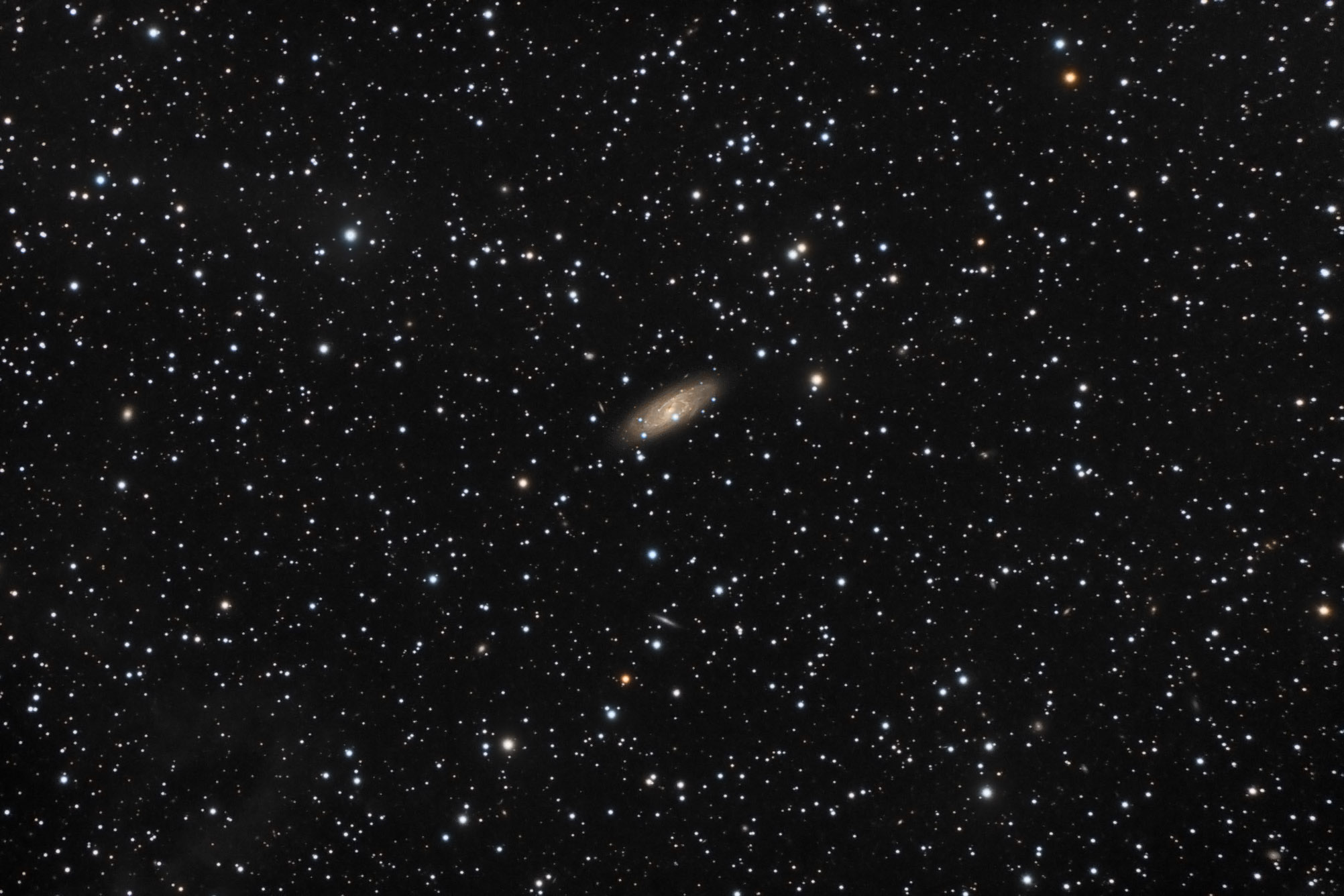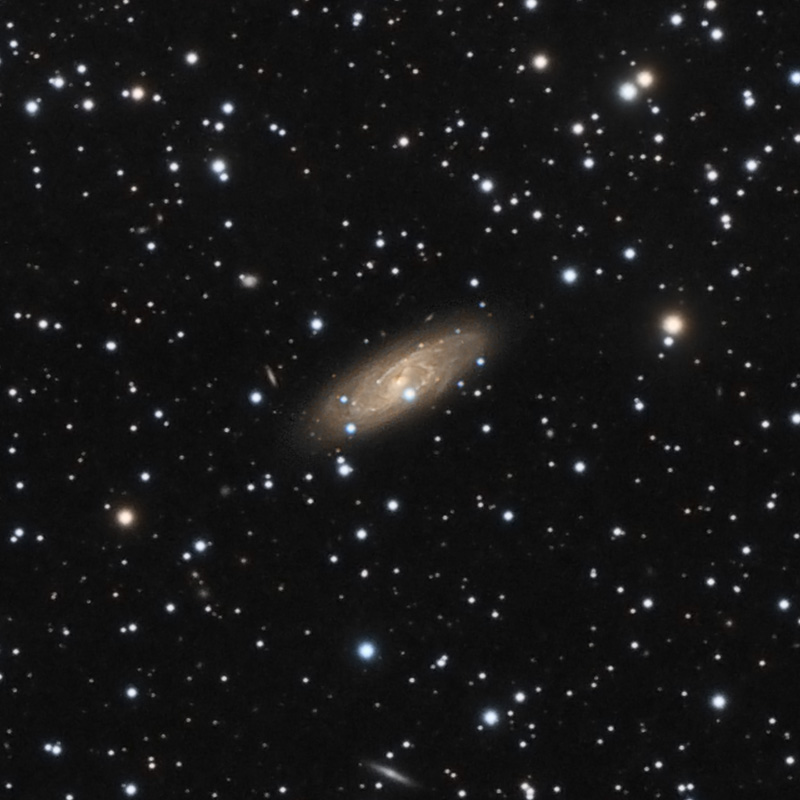Object name: NGC1174Designation(s): NGC1174, NGC1186, NGC 1174/1186 made my to-do list for being a good example of the newly discovered class of galaxies called Red Spiral Galaxies. Also it has some very interesting structure. Located in western Perseus about 4.25 degrees east of M34. It is thought to be about 120 million light-years away. NED classes it as SB(r)bc: while the NGC Project closely agrees saying SBb-c. The only other galaxy in the image with redshift data is NPM1G +42.0108 at twice the distance, 245 million light-years. It is the elliptical like galaxy due east (left) of NGC 1174 not far from the left edge of the image. Only a very few other galaxies are even listed in NED, none with classification, distance or magnitude. All are from the 2MASS survey. Therefore I didn't bother to make an annotated image.
The galaxy was first seen by William Herschel on October 27, 1786. Dreyer recorded that sighting as NGC 1186. Lewis Swift saw it on August, 31, 1883. That entry was recorded by Dreyer as NGC 1174. Apparently neither got the position quite right. Several (William Parsons, Heinrich d'Arrest and maybe Guillaume Bigourdan) looked for it but could not find it. Bigourdan may or may not have found it. Rudolf Spitaler was the first to realize they were the same object. It isn't in either H400 observing program.
Red spirals are somewhat of a puzzle in that they shouldn't exist by some theories of spiral galaxy formation. The arms are thought to be created by density waves powered by the light pressure of massive stars and the shockwave from the super novas they create when they die. Thus they are a self perpetuating feature. But they need a supply of new stars to keep them going. New star formation creates a lot of super hot blue stars needed to power the density waves. Thus spiral arms are blue with their light dominated by these super stars. If star formation ceases super hot stars die and with it, the theory goes, so does the spiral structure. Yet these red spirals too weak in such stars to have the spiral structure seen. Something else is going on or these stars are not seen.
Most red spirals are seen in galaxy clusters and there is a theory for them saying that as they get drawn in to the center region of the cluster from the outskirts where most blue spirals live that this somehow slowly strangles star formation but does so gently enough the spiral structure remains for at least a short period. You can read more about that at: http://www.universetoday.com/21457/unusual-red-spiral-galaxies-strangled/ or you can read the gory details (hip waders may be useful) at:
http://arxiv.org/abs/0910.4113 .
The theory says this happens mostly to larger spiral galaxies. Well NGC 1174 is a large galaxy. I get a size of just about 100,000 light-years and as spirals go that is big. But it isn't in a galaxy cluster. It is considered part of a very sparse and widely separated group known as the NGC 1186 group. It is so spread out no other member is in my image. Certainly not anything like what the theory of strangled spirals requires. Nor is this a case of the galaxy being reddened by dust in our galaxy as even more distant galaxies right near it are quite blue. Unless the dust is only directly in line with NGC 1174 and is a small cloud would that happen. Spectroscopic data would prove the issue one way or the other but that's not available. I'll just say I can't buy all the coincidences needed for this to be dust reddening either in our galaxy or because NGC 1174 is in a dusty cocoon.
One answer may be that these galaxies do have current star formation going on but had so much formation in the past that the red stars from that era are still around in vast numbers thus skewing the color to red even though there are a normal number of stars being formed in a spiral galaxy. Studies of some of these with IR and UV light seems to support this. For this you need a galaxy with 10 billion times the mass of the sun. Is NGC 1174 that big? I don't know. It certainly appears to have the dust and gas needed for sustained star formation. In any case again this study was done using cluster galaxies from the same Galaxy Zoo articles referred to in the above links. You can read about this idea at:
http://astrobites.org/2012/06/06/red-spirals-are-not-dead/ The URL pretty much tells the story.
The field contains weak IFN which is strongest to the lower left. I see hints of it in the POSS plates so am quite confident it is real. This might be a good field for those that spend many hours on a target would find interestingly dusty. I don't begin to have the needed time into my image to bring it out.
14" LX200R @ f/10, L=4x10' RGB=2x10', STL-11000XM, Paramount MENGC 1174 made my to-do list for being a good example of the newly discovered class of galaxies called Red Spiral Galaxies. Also, it has some very interesting structure. Located in western Perseus about 4.25 degrees east of M34. It is thought to be about 120 million light-years away. NED classes it as SB(r)bc: while the NGC Project closely agrees saying SBb-c. The only other galaxy in the image with redshift data is NPM1G +42.0108 at twice the distance, 245 million light-years. It is the elliptical like galaxy due east (left) of NGC 1174 not far from the left edge of the image. Only a very few other galaxies are even listed in NED, none with classification, distance or magnitude. All are from the 2MASS survey. Therefore I didn't bother to make an annotated image.
The galaxy was first seen by William Herschel on October 27, 1786. Dreyer recorded that sighting as NGC 1186. Lewis Swift saw it on August 31, 1883. That entry was recorded by Dreyer as NGC 1174. Apparently, neither got the position quite right. Several (William Parsons, Heinrich d'Arrest and maybe Guillaume Bigourdan) looked for it but could not find it. Bigourdan may or may not have found it. Rudolf Spitaler was the first to realize they were the same object. It isn't in either H400 observing program.
Red spirals are somewhat of a puzzle in that they shouldn't exist by some theories of spiral galaxy formation. The arms are thought to be created by density waves powered by the light pressure of massive stars and the shockwave from the supernovas they create when they die. Thus they are a self-perpetuating feature. But they need a supply of new stars to keep them going. New star formation creates a lot of super hot blue stars needed to power the density waves. Thus spiral arms are blue with their light dominated by these superstars. If star formation ceases super hot stars die and with it, the theory goes, so does the spiral structure. Yet these red spirals too weak in such stars to have the spiral structure seen. Something else is going on or these stars are not seen.
Most red spirals are seen in galaxy clusters and there is a theory for them saying that as they get drawn into the center region of the cluster from the outskirts where most blue spirals live that this somehow slowly strangles star formation but does so gently enough the spiral structure remains for at least a short period. You can read more about that at: http://www.universetoday.com/21457/unusual-red-spiral-galaxies-strangled/ or you can read the gory details (hip waders may be useful) at:
http://arxiv.org/abs/0910.4113 .
The theory says this happens mostly to larger spiral galaxies. Well NGC 1174 is a large galaxy. I get a size of just about 100,000 light-years and as spirals go that is big. But it isn't in a galaxy cluster. It is considered part of a very sparse and widely separated group known as the NGC 1186 group. It is so spread out no other member is in my image. Certainly not anything like what the theory of strangled spirals requires. Nor is this a case of the galaxy being reddened by dust in our galaxy as even more distant galaxies right near it are quite blue. Unless the dust is only directly in line with NGC 1174 and is a small cloud would that happen. Spectroscopic data would prove the issue one way or the other but that's not available. I'll just say I can't buy all the coincidences needed for this to be dust reddening either in our galaxy or because NGC 1174 is in a dusty cocoon.
One answer may be that these galaxies do have current star formation going on but had so much formation in the past that the red stars from that era are still around in vast numbers thus skewing the color to red even though there are a normal number of stars being formed in a spiral galaxy. Studies of some of these with IR and UV light seems to support this. For this, you need a galaxy with 10 billion times the mass of the sun. Is NGC 1174 that big? I don't know. It certainly appears to have the dust and gas needed for sustained star formation. In any case, again this study was done using cluster galaxies from the same Galaxy Zoo articles referred to in the above links. You can read about this idea at:
http://astrobites.org/2012/06/06/red-spirals-are-not-dead/ The URL pretty much tells the story.
The field contains weak IFN which is strongest to the lower left. I see hints of it in the POSS plates so am quite confident it is real. This might be a good field for those that spend many hours on a target would find interestingly dusty. I don't begin to have the needed time into my image to bring it out.
14" LX200R @ f/10, L=4x10' RGB=2x10', STL-11000XM, Paramount ME Related Designation(s):2MASS J03053088+4250079, 2MASX J03053084+4250076, 2MASXi J0305308+425006, AKARI J0305303+425010, CGCG 0302.2+4239, CGCG 540-034, HDCE 0207 NED002, IRAS 03022+4238, IRAS F03022+4238, LDCE 0224 NED108, LGG 082:[G93] 002, MCG +07-07-021, NGC 1174, NGC 1186, NGC1174, NGC1186, NSA 155418, NVSS J030530+425007, PGC 011617, UGC 02521, UZC J030530.7+425005, | | 
